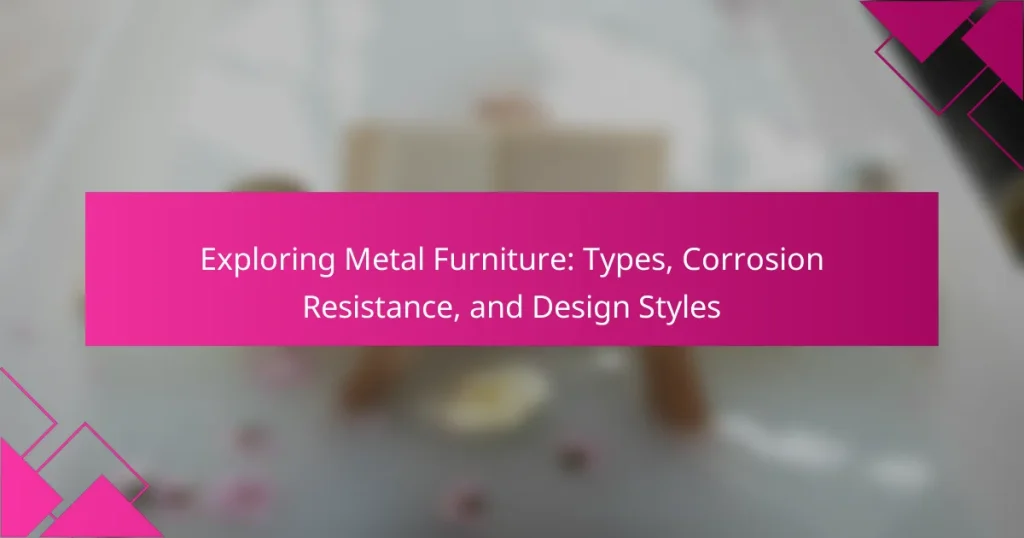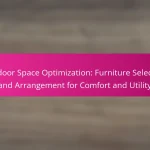Metal furniture is defined as furniture primarily constructed from metal materials, including steel, aluminum, wrought iron, and stainless steel. Known for its durability and strength, metal furniture is appropriate for both indoor and outdoor use, featuring modern designs and clean lines. Corrosion resistance is a crucial factor that enhances the longevity of metal furniture, with treatments available to prevent rust and degradation. The article explores various types of metal furniture, their functional and aesthetic applications, and the design styles they complement, such as industrial, modern, and minimalist. Additionally, it highlights the importance of corrosion-resistant materials in maintaining the visual appeal and usability of metal furniture over time.
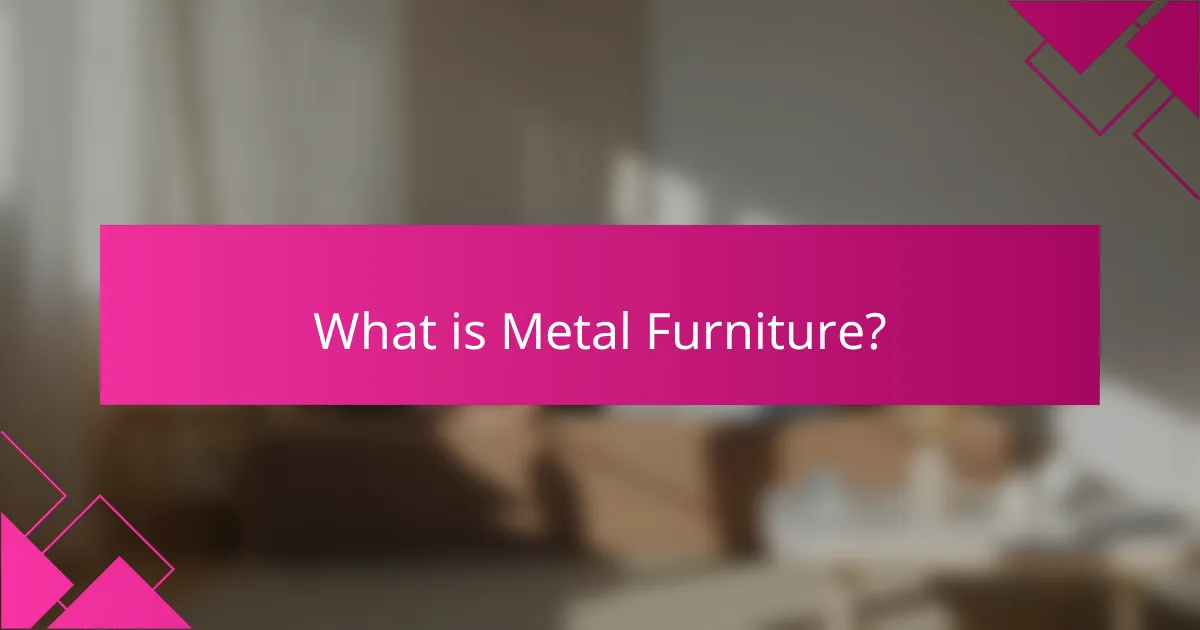
What is Metal Furniture?
Metal furniture refers to furniture made primarily from metal materials. Common metals used include steel, aluminum, and wrought iron. This type of furniture is known for its durability and strength. Metal furniture often features modern designs and clean lines. It is suitable for both indoor and outdoor settings. Metal furniture is resistant to wear and tear, making it a long-lasting option. Additionally, metal can be treated to resist corrosion, enhancing its lifespan. Many manufacturers offer various finishes and styles, catering to diverse aesthetic preferences.
How is Metal Furniture Defined?
Metal furniture is defined as furniture made primarily from metal materials. This includes items like chairs, tables, and cabinets constructed from materials such as steel, aluminum, or wrought iron. Metal furniture is known for its durability and strength. It often features a modern aesthetic, appealing to contemporary design preferences. The use of metal in furniture allows for various finishes, including powder coating and plating. Metal furniture is also resistant to wear and tear, making it suitable for both indoor and outdoor use. According to industry reports, metal furniture has gained popularity due to its longevity and low maintenance requirements.
What materials are commonly used in Metal Furniture?
Common materials used in metal furniture include steel, aluminum, and wrought iron. Steel is durable and often used for its strength. Aluminum is lightweight and resistant to rust, making it ideal for outdoor furniture. Wrought iron features intricate designs and offers a classic look. Additionally, stainless steel is popular for its corrosion resistance and modern aesthetic. These materials are chosen for their properties, ensuring longevity and aesthetic appeal in various designs.
What are the typical applications of Metal Furniture?
Metal furniture is commonly used in various applications due to its durability and aesthetic appeal. Typical applications include office environments, where metal desks and chairs provide a modern look and long-lasting use. In outdoor settings, metal furniture such as patio tables and chairs withstand weather conditions effectively. Additionally, metal shelving units are frequently utilized in warehouses and retail spaces for storage solutions. Metal furniture is also popular in schools and universities, offering sturdy seating and work surfaces. Its versatility allows it to fit into residential spaces, including dining tables and accent pieces. The strength of metal furniture supports heavy loads, making it suitable for commercial and industrial uses. Overall, metal furniture’s applications span across both functional and decorative needs in diverse environments.
What are the Key Characteristics of Metal Furniture?
Metal furniture is known for its durability and strength. It typically withstands heavy use and resists wear and tear. Metal furniture is also resistant to moisture, making it suitable for various environments. Its maintenance is generally easy, requiring only occasional cleaning. Metal furniture often features a modern aesthetic, appealing to contemporary design preferences. It can be finished in various colors and textures, enhancing its versatility. Additionally, metal furniture is often lightweight, allowing for easy rearrangement. Many designs incorporate ergonomic features for comfort and usability.
How does durability play a role in Metal Furniture?
Durability is a critical factor in metal furniture, influencing its lifespan and usability. Metal furniture is designed to withstand wear and tear over time. This durability is primarily due to the inherent strength of metals like steel and aluminum. These materials resist bending, breaking, and warping under pressure. Additionally, metal furniture often undergoes protective treatments, such as powder coating, to enhance resistance to corrosion and rust. For example, galvanized steel can last for decades in outdoor environments. The durability of metal furniture makes it suitable for both residential and commercial applications. It can endure heavy usage in high-traffic areas without significant damage. Overall, durability ensures that metal furniture remains functional and aesthetically pleasing for an extended period.
What aesthetic qualities can be found in Metal Furniture?
Metal furniture often exhibits sleekness and modernity. Its aesthetic qualities include durability and a contemporary look. The finish of metal can range from shiny to matte, influencing its visual appeal. Metal furniture is versatile, fitting various design styles from industrial to minimalist. It can be easily shaped into intricate designs, adding uniqueness. The reflective surfaces can enhance light in a space, creating an open feel. Additionally, metal can be combined with other materials like wood or glass for added texture. These qualities make metal furniture a popular choice in both residential and commercial settings.
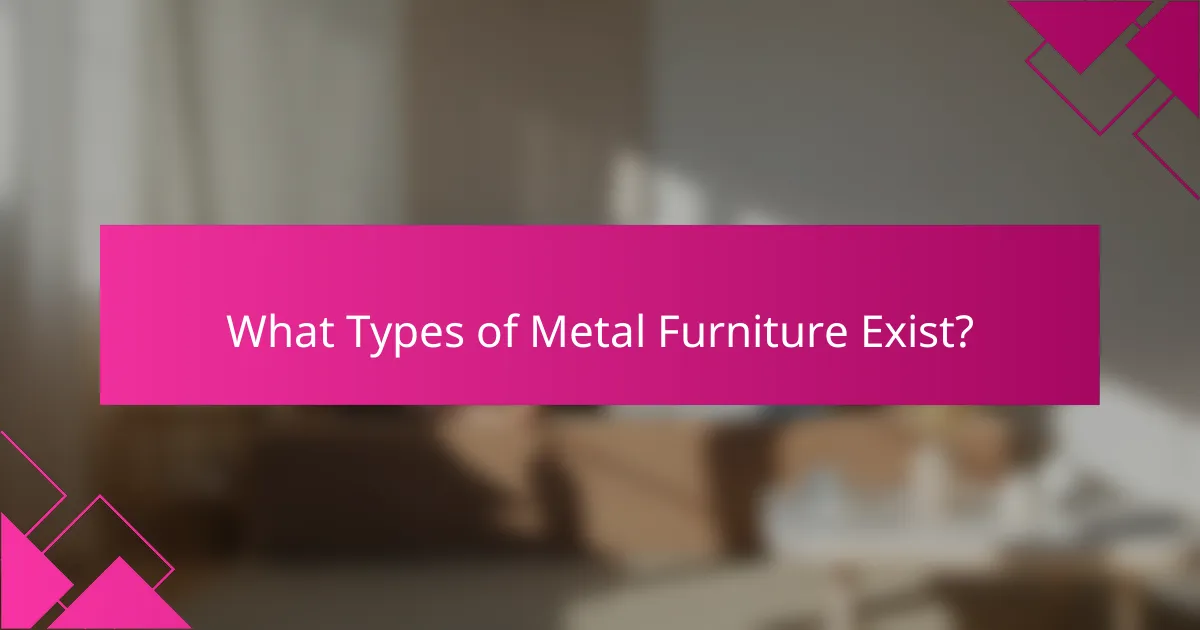
What Types of Metal Furniture Exist?
Metal furniture types include steel, aluminum, wrought iron, and stainless steel. Steel furniture is known for its strength and durability. Aluminum furniture is lightweight and resistant to corrosion. Wrought iron furniture offers a classic aesthetic with intricate designs. Stainless steel furniture is popular for its modern look and resistance to rust. Each type serves different functional and aesthetic purposes in various settings.
What are the Different Categories of Metal Furniture?
The different categories of metal furniture include indoor furniture, outdoor furniture, and specialized furniture. Indoor furniture typically consists of items like metal chairs, tables, and cabinets. Outdoor furniture often features weather-resistant materials, including metal patio sets and benches. Specialized furniture encompasses items designed for specific uses, such as metal shelving units or industrial workstations. Each category serves distinct purposes and environments.
How do indoor and outdoor Metal Furniture differ?
Indoor metal furniture typically features designs optimized for aesthetics and comfort. It often incorporates materials that prioritize visual appeal and may have finishes that are sensitive to moisture. Outdoor metal furniture, on the other hand, is designed for durability and weather resistance. It uses materials that can withstand elements like rain and UV exposure.
Indoor furniture may include softer edges and intricate designs, while outdoor options often have a more robust construction. Outdoor metal furniture frequently uses powder coating or galvanization to prevent rust. Indoor pieces may rely on paint or lacquer finishes that are not suitable for outdoor conditions.
The distinction is crucial for longevity and usability. Choosing the wrong type can lead to deterioration or discomfort.
What are the popular styles of Metal Furniture available?
Popular styles of metal furniture include industrial, contemporary, vintage, and minimalist designs. Industrial metal furniture features raw materials and a rugged aesthetic. Contemporary styles focus on sleek lines and modern finishes. Vintage metal furniture often showcases intricate designs and nostalgic elements. Minimalist designs emphasize simplicity and functionality. These styles cater to diverse tastes and interior themes. Each style utilizes metal’s durability and versatility.
What Factors Influence the Selection of Metal Furniture?
The selection of metal furniture is influenced by several factors. Durability is a primary consideration, as metal furniture is known for its strength and longevity. Aesthetic appeal also plays a crucial role; the design and finish can complement various interior styles. Weight and mobility are important, especially for versatile spaces. Corrosion resistance is vital for outdoor use, ensuring longevity against weather elements. Cost is another significant factor; budget constraints can limit options. Maintenance requirements also influence choices; some metals require more upkeep than others. Finally, environmental impact is increasingly considered, with consumers preferring sustainably sourced materials.
How does the intended use affect the choice of Metal Furniture?
The intended use significantly influences the choice of metal furniture. For instance, outdoor metal furniture must be corrosion-resistant to withstand weather elements. This is often achieved using materials like aluminum or treated steel. Indoor metal furniture may prioritize aesthetics and comfort over durability. Different styles, such as industrial or modern, cater to various interior designs. The weight capacity is crucial for furniture intended for heavy use, like commercial settings. Additionally, ease of maintenance is essential for frequently used items. Therefore, understanding the intended use guides material selection, design, and functionality in metal furniture.
What role does design play in selecting Metal Furniture?
Design plays a crucial role in selecting metal furniture. It influences aesthetics, functionality, and suitability for specific spaces. A well-designed piece enhances the visual appeal of an environment. Design also determines the ergonomics and comfort of the furniture. Different styles, such as industrial or modern, cater to diverse consumer preferences. Additionally, the design affects the durability and maintenance of metal furniture. For example, powder-coated finishes can improve corrosion resistance. Ultimately, thoughtful design ensures that metal furniture meets both practical and aesthetic needs.
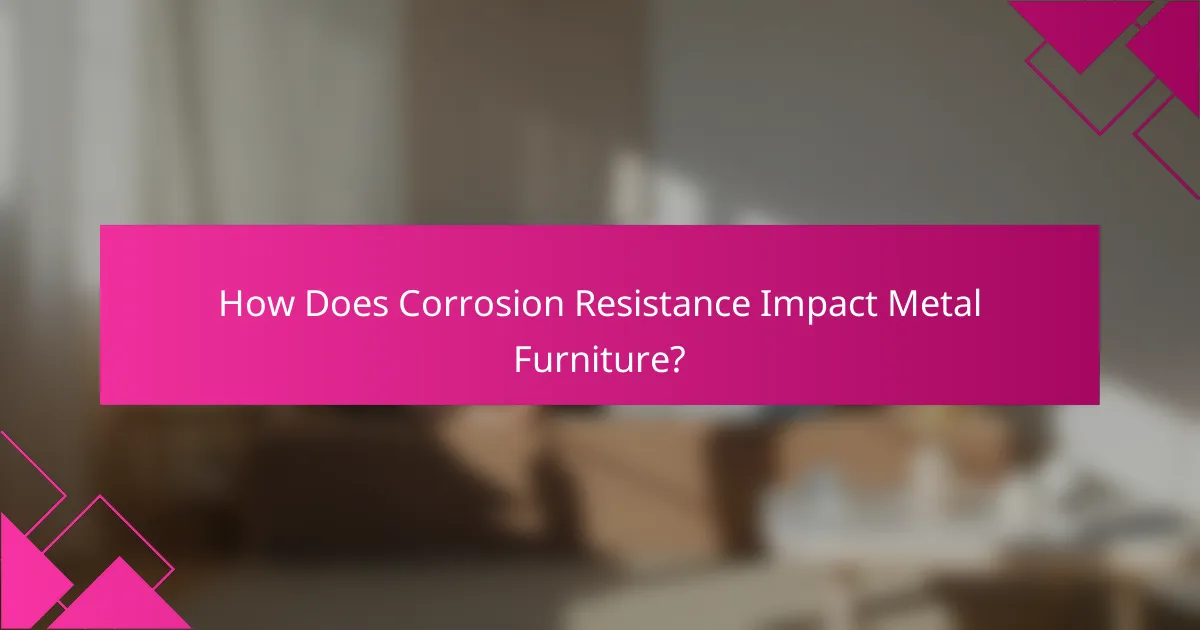
How Does Corrosion Resistance Impact Metal Furniture?
Corrosion resistance significantly impacts the durability and lifespan of metal furniture. It prevents rust and degradation caused by moisture and environmental factors. Furniture made from corrosion-resistant materials, such as stainless steel or aluminum, maintains its aesthetic appeal over time. This resistance reduces maintenance costs and prolongs usability. According to a study published in the Journal of Materials Science, corrosion-resistant coatings can extend the life of metal furniture by up to 50%. Enhanced corrosion resistance ensures that metal furniture remains functional and visually appealing in various settings.
What is Corrosion Resistance in Metal Furniture?
Corrosion resistance in metal furniture refers to the ability of metal materials to withstand deterioration caused by environmental factors. This property is crucial for maintaining the appearance and structural integrity of furniture exposed to moisture and chemicals. Metals like stainless steel and aluminum are known for their high corrosion resistance due to their protective oxide layers. For example, stainless steel contains chromium, which forms a passive layer that prevents rust. Additionally, coatings such as powder coating can enhance corrosion resistance by providing a barrier against moisture. This resistance is essential for outdoor metal furniture, which faces harsher conditions.
How do different metals compare in terms of corrosion resistance?
Metals differ significantly in corrosion resistance. Stainless steel is highly resistant due to its chromium content, which forms a protective oxide layer. Aluminum also exhibits good resistance due to its oxide layer, making it suitable for outdoor use. Copper resists corrosion well but can develop a patina over time. On the other hand, mild steel is prone to rusting when exposed to moisture without protective coatings. Galvanized steel, coated with zinc, offers enhanced protection against corrosion. Titanium is exceptionally resistant to corrosion, even in harsh environments. These differences are crucial for selecting materials for metal furniture, ensuring longevity and durability.
What treatments can enhance corrosion resistance in Metal Furniture?
Treatments that can enhance corrosion resistance in metal furniture include powder coating, galvanization, and the application of anti-corrosive paints. Powder coating involves applying a dry powder that is then cured under heat, creating a protective layer. This method is known for its durability and resistance to chipping and scratching. Galvanization is the process of coating metal with zinc to prevent rust. It is widely used for outdoor metal furniture due to its effectiveness in harsh environments. Anti-corrosive paints contain special additives that inhibit rust formation. These paints can be applied to various metal surfaces to provide a protective barrier. Each treatment significantly extends the lifespan of metal furniture by reducing susceptibility to corrosion.
Why is Corrosion Resistance Important for Metal Furniture?
Corrosion resistance is crucial for metal furniture to ensure durability and longevity. Metal furniture is often exposed to moisture and environmental elements. Without corrosion resistance, metal can rust and deteriorate over time. This degradation compromises the structural integrity of the furniture. Additionally, corrosion can lead to unsightly stains and damage. Maintaining aesthetic appeal is important for consumer satisfaction. Corrosion-resistant materials, such as stainless steel or treated aluminum, extend the lifespan of metal furniture. Studies show that corrosion-resistant finishes can significantly reduce maintenance costs over time.
How does corrosion affect the lifespan of Metal Furniture?
Corrosion significantly reduces the lifespan of metal furniture. It causes deterioration of the metal surface, leading to structural weakness. Over time, corrosion can result in visible rust and flaking. This degradation compromises the furniture’s aesthetic appeal and functionality. Studies show that untreated metal can corrode within a few years in humid environments. Protective coatings can extend the lifespan by preventing moisture exposure. However, without such measures, metal furniture may require frequent replacement. Thus, corrosion is a critical factor in determining the longevity of metal furniture.
What maintenance practices can help prevent corrosion?
Regular maintenance practices can significantly prevent corrosion. These practices include applying protective coatings, such as paint or galvanization, to metal surfaces. Regular inspections allow for early detection of any signs of rust or wear. Cleaning metal surfaces helps remove contaminants that can accelerate corrosion. Additionally, ensuring proper drainage prevents water accumulation, which can lead to corrosion. Using corrosion inhibitors in environments with high humidity is also effective. Finally, storing metal furniture in dry, covered areas reduces exposure to moisture. These methods have been proven to extend the lifespan of metal furniture by minimizing corrosion risks.
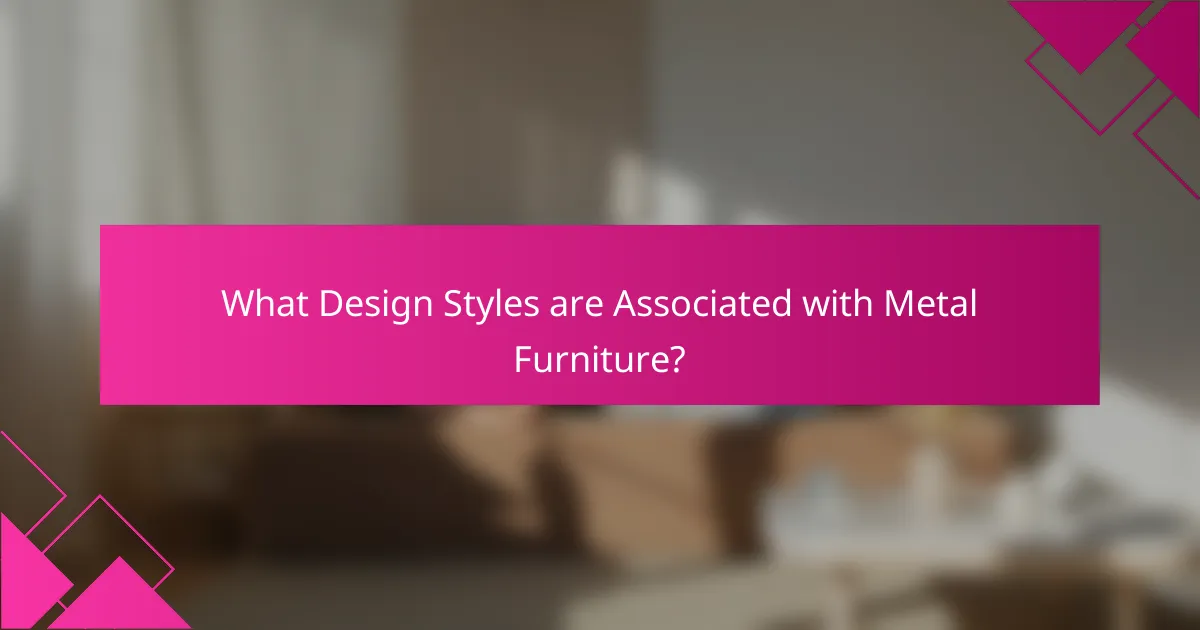
What Design Styles are Associated with Metal Furniture?
Metal furniture is commonly associated with several design styles, including industrial, modern, and minimalist. Industrial design often features raw metal finishes and utilitarian forms. This style emphasizes functionality and the use of reclaimed materials. Modern design incorporates sleek lines and polished surfaces, highlighting the aesthetic appeal of metal. Minimalist design focuses on simplicity and clean spaces, often utilizing metal for its durability and understated elegance. Each of these styles showcases the versatility of metal furniture in various interior settings.
What Popular Design Styles Feature Metal Furniture?
Popular design styles that feature metal furniture include industrial, modern, and mid-century modern. Industrial design emphasizes raw materials, with metal furniture often showcasing a rugged aesthetic. Modern design incorporates sleek lines and minimalism, frequently using metal for its clean look. Mid-century modern combines organic forms with metal, creating functional yet stylish pieces. These styles highlight metal’s versatility and durability in various settings.
How does Industrial design incorporate Metal Furniture?
Industrial design incorporates metal furniture through functionality, aesthetics, and durability. Metal furniture is often designed to be practical for various environments. It provides strength while maintaining a sleek appearance. Industrial design emphasizes clean lines and minimalism, which metal furniture embodies well. The use of metals like steel and aluminum enhances longevity and resistance to wear. Designers often explore innovative forms and finishes to elevate the visual appeal of metal furniture. Additionally, metal’s recyclability aligns with sustainable design principles. This integration supports both modern and traditional aesthetics in diverse settings.
What elements define Modern design with Metal Furniture?
Modern design with metal furniture is defined by minimalism, functionality, and sleek aesthetics. This style emphasizes clean lines and geometric shapes. It often incorporates materials like stainless steel or aluminum for durability. The color palette is typically neutral, focusing on blacks, whites, and grays. Additionally, modern metal furniture often features innovative designs that prioritize space efficiency. The use of mixed materials, such as wood or glass, enhances visual interest. Functionality is key, with pieces designed for versatile use. These elements collectively create a contemporary look that is both stylish and practical.
How can Metal Furniture Complement Various Interior Styles?
Metal furniture can complement various interior styles through its versatility and aesthetic appeal. Its sleek design enhances modern and industrial themes. Metal furniture can also add an elegant touch to contemporary and minimalist spaces. The durability of metal makes it suitable for both indoor and outdoor settings. Different finishes, such as matte or polished, can align with diverse design preferences. For instance, rustic metal pieces can enrich farmhouse styles. Meanwhile, chrome or stainless steel can elevate a mid-century modern look. The adaptability of metal allows for seamless integration across various decor themes.
What are the best practices for integrating Metal Furniture into home decor?
To effectively integrate metal furniture into home decor, select pieces that complement existing design elements. Consider the color palette of your space; metal furniture can enhance or contrast colors. Use metal accents to create a cohesive look, tying in with other metallic decor items. Balance metal with softer materials like wood or textiles to avoid a cold atmosphere. Ensure the scale of metal furniture fits the space; oversized pieces can overwhelm smaller rooms. Mix different metal finishes for visual interest, but maintain a unifying theme. Incorporate plants or textiles to soften the industrial feel of metal furniture. Proper placement is crucial; arrange furniture for functionality and flow in the room.
How can Metal Furniture enhance functionality in different spaces?
Metal furniture enhances functionality in various spaces through durability, versatility, and aesthetic appeal. Its robust nature allows it to withstand heavy use in commercial settings. Metal furniture is lightweight, making it easy to rearrange in residential spaces. It can be customized to fit different design styles, from industrial to modern. Metal surfaces are easy to clean and maintain, which is beneficial in high-traffic areas. Additionally, metal furniture often incorporates multifunctional designs, such as storage solutions and convertible pieces. This adaptability maximizes space efficiency, especially in smaller environments. Overall, metal furniture provides practical solutions while complementing diverse interior styles.
What Tips Should You Consider When Choosing Metal Furniture?
When choosing metal furniture, consider durability, style, and maintenance requirements. Metal furniture is often robust and can withstand wear. Look for corrosion-resistant finishes, especially for outdoor use. Assess the weight and stability of the furniture; heavier pieces are typically more stable. Choose a style that complements your existing decor. Examine welds and joints for quality; strong joints enhance durability. Check for any sharp edges or finishes that could cause injury. Lastly, consider the ease of cleaning; some metals require more maintenance than others.
Metal furniture, primarily constructed from materials such as steel, aluminum, and wrought iron, is recognized for its durability, strength, and modern aesthetic. This article explores various types of metal furniture, its resistance to corrosion, and the design styles associated with it, including industrial, modern, and minimalist. Key characteristics, applications, and the impact of corrosion resistance on longevity are examined, alongside tips for selecting and integrating metal furniture into diverse environments. The comprehensive overview provides insights into the versatility and functionality of metal furniture in both residential and commercial settings.
